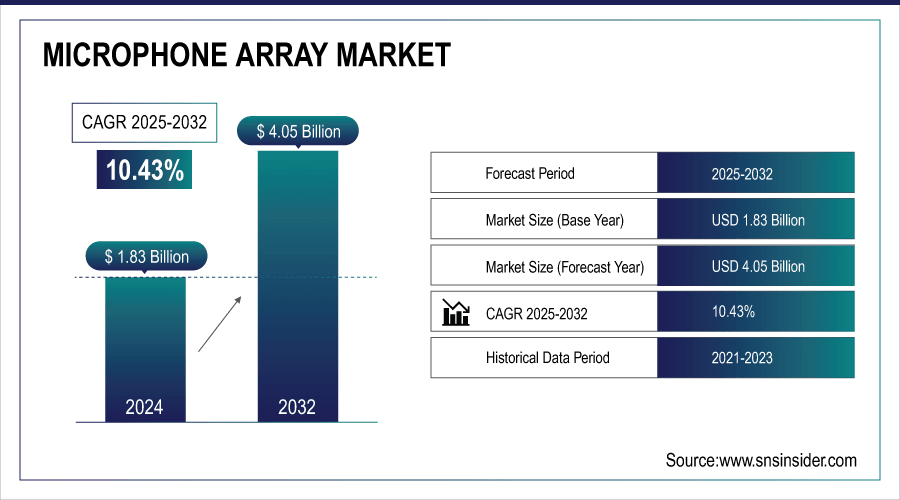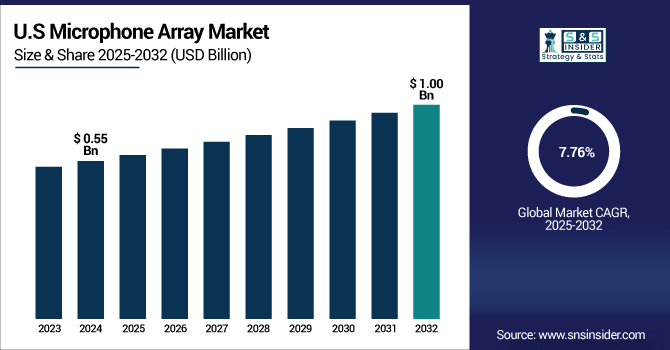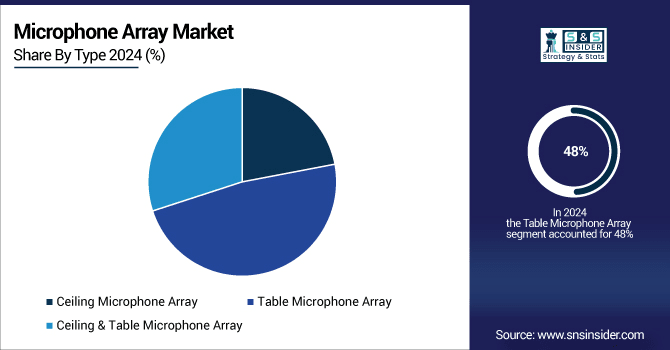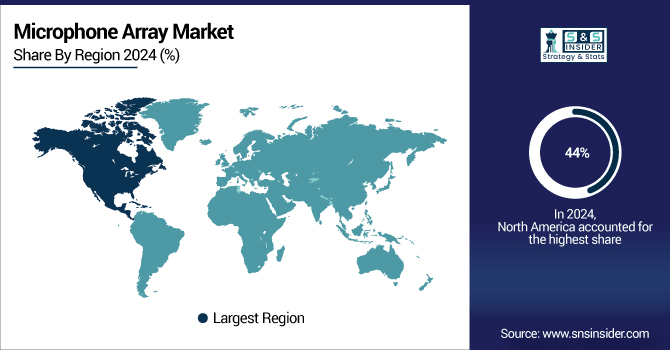Microphone Array Market Size Analysis:
The Microphone Array Market size was valued at USD 1.83 Billion in 2024 and is projected to reach USD 4.05 Billion by 2032, growing at a CAGR of 10.43% during 2025-2032.
The microphone array market driven by the high-level of demand for voice enabled devices in the automotive, smart home, conferencing, and healthcare segments. Improvements in beam-forming, noise-suppression and MEMS sensor technique are allowing achieving higher level of integration and more accurate technology in terms of microphone array in products including virtual assistants, smart speakers, and telemedicine appliances. Rise in penetration of smart devices and emergence of high definition voice quality requirement in communication systems fuel the market. Investments is increasing in voice recognition and noise-cancellation (AI-powered) to aid in innovation, making audio fitters better, more advanced and scalable across a number of applications in all regions.

To Get More Information On Microphone Array Market - Request Free Sample Report
Baidu announced the Xiaodu AI Glasses at the 2024 Baidu World Conference which boasts a 16MP ultra-wide camera, as well as a four-microphone array for enhanced AI interaction. The glasses are lightweight and provide real-time AI support for up to five hours on a single charge with a 56 hours standby battery.
The U.S Microphone Array Market size was valued at USD 0.55 Billion in 2024 and is projected to reach USD 1.00 Billion by 2032 growing at a CAGR of 7.76% during 2025-2032, on account of increasing inclination towards voice controlled applications in consumer devices such as smart home devices and automotive infotainment. An accelerating step up in the use of virtual assistants, conferencing products and surveillance technologies will also drive growth. Beamforming and noise cancellation techniques become attractively powerful tools to operate in microphone arrays due to the improvements of technology.

Microphone Array Market Dynamics:
Drivers:
-
Increased Demand for Voice-Enabled Devices Fuels Growth in Microphone Array Market
The market for microphone array is primarily driven by the increasing demand for voice operated systems, owing to the increasing pace of smart device adoption and usage of voice-operated interfaces. As smart speakers, in-car assistants, and virtual-meeting platforms are more widely used among users and industries, we need more clear and accurate voice input. This requirement has spurred development in microphone array technology, in the beamforming and noise suppression. As a result, devices are better able to separate out human speech from ambient noise, fostering more accurate voice recognition and interactivity. Thereby, it is driving to integrate microphone arrays into most of the applications contributing to the growth of the market in both consumer and enterprise segment.
DLR’s A320 ATRA flight tests over a 120×340 m, 30-microphone array at Cochstedt Airport showed that retrofitting with eight noise-reduction technologies cut individual component noise by up to 6 dB and overall flyover noise by 3 dB reducing perceived ground-level noise by about 30%.
Restraints:
-
Technical Complexity in Integration Causes Delays and Increased Costs in Microphone Array Adoption
The complexity involved in integrating microphone arrays into existing devices and systems often leads to significant delays and increased costs. These arrays need precise calibration and to be interoperable with existing hardware and software, so the process requires specialist technical knowledge. This can lead to long development times and increased costs for producers, who see their product introductions slowed and market acceptance hampered. Furthermore, the trouble shooting and optimization of microphone array performance in a variety of environments are also adding complexity to the integration process. Thus, enterprises may be reserved in adopting the technology, which is expected to impact the overall market growth. The complex integration process acts as a key obstacle, leading to long slow innovation cycles and preventing microphone arrays from being widely deployed in different applications and verticals.
Opportunities:
-
AI Innovations and Simplified Deployment Enhance Microphone Array Market Expansion
Advancements in AI and immersive technologies are creating substantial growth opportunities in the microphone array market. Microphones with the ability to adapt to speaker positions and room acoustic conditions deliver clarity of sound, stimulating demand in the hybrid workspace and smart environment market. Ease of deployment and AI features such as real-time diagnostics, workflow automation and AI-generated content all enhance collaboration and user experience. These advances expand the use of microphone arrays for corporate, education, health care and teleconferencing applications to deliver better communication tools for these markets. With smart and connected technologies becoming more prevalent in the enterprise, the market for microphone arrays is set to grow rapidly, with changing requirements in the workplace and advancing technologies driving demand.
Cisco unveiled AI-powered solutions including the Ceiling Microphone Pro and Cisco Spatial Meetings, enhancing hybrid workspaces with immersive audio and video integration for Apple Vision Pro users. New tools also streamline meeting management and real-time issue resolution.
Challenges:
-
High Manufacturing Costs Limit Widespread Adoption of Microphone Arrays
The high costs of manufacturing and implementing sophisticated microphone array systems are significant challenges. AI-based noise cancellation, beamforming and multi-mic synchronization as manufacturers have to combine complex hardware and software components, it makes the production costs more expensive. Moreover, the incorporation of these complex systems are demanding in terms of specialized engineering and tailoring, also adding to the cost. For a manufacturer, striking the balance between performance and cost has always been a daunting task, especially in the consumer electronics markets requiring cost-sensitive products. Increased pricing, often hindered rapid market uptake and penetration, especially in the low price-sensitive industries. As a result, the cost intensity of a microphone array deters widespread use; it is a deterrent for explosive growth and acceptance of this new technology in a wide array of markets.
Microphone Array Market Segmentation Analysis:
By Type
The table microphone array segment held a dominant microphone array market share of around 48% in 2024, driven by increasing demand for clear, high-quality audio in remote work, virtual meetings, and conferencing. Its easy installation, superior voice pickup accuracy, and seamless integration with communication platforms make it highly preferred in corporate and educational settings, fueling market growth.

The ceiling microphone array segment is expected to experience the fastest growth in the microphone array market over 2025-2032 with a CAGR of 13.45%. This growth is fueled by increased use in smart buildings, corporate offices, and conference rooms, where ceiling-mounted arrays offer seamless, wide-area audio capture. Their unobtrusive design and superior sound quality boost demand in modern communication and collaboration systems.
By Technology
The beamforming segment held a dominant microphone array market share of around 35% in 2024, driven by its ability to enhance audio clarity and focus on specific sound sources. This technology is increasingly adopted in smart devices, conferencing systems, and voice-controlled applications, where precise sound capture and noise reduction are critical, fueling strong demand and market growth.
The 3D Audio array segment is expected to experience the fastest growth in the microphone array market over 2025-2032 with a CAGR of 21.15%. This surge is driven by rising demand for immersive audio experiences in gaming, virtual reality, and entertainment, alongside advancements in spatial sound technology that enhance user engagement and audio precision across various applications.
By Application
The consumer electronics segment held a dominant microphone array market share of around 35% in 2024, This growth is fueled by the widespread use of smart devices like smartphones, smart speakers, and wearables that rely on advanced audio technology. Increasing demand for superior voice recognition and hands-free features is driving the rapid expansion of this segment in the market.
The automotive segment is expected to experience the fastest growth in the microphone array market over 2025-2032 with a CAGR of 12.74%. This growth is fueled by the rising integration of advanced driver-assistance systems (ADAS), voice-activated controls, and in-car communication technologies, driving increased demand for sophisticated microphone array solutions in vehicles.
Microphone Array Market Regional Overview:
In 2024, the North America dominated the microphone array market and accounted for 44% of revenue share. This leadership is driven by early adoption of advanced technologies, strong presence of key industry players, and widespread use of smart devices across various sectors such as automotive, healthcare, and telecommunications. Additionally, growing investments in research and development, along with increasing demand for high-quality audio solutions in corporate and consumer markets, are fueling sustained growth in the region.

Get Customized Report as Per Your Business Requirement - Enquiry Now
The U.S. leads the microphone array market, due to early adoption of smart technologies, strong presence of tech companies, growing demand for voice-activated devices, and increased investment in AI-driven audio solutions.
Asia-Pacific is projected to register the fastest CAGR of 11.99% during 2025-2032, driven by rapid urbanization, government initiatives promoting smart cities, increasing adoption of IoT and AI technologies, expanding electronics manufacturing, and rising consumer demand for advanced audio and communication devices. These factors collectively fuel robust growth in the microphone array market in the region.
In 2024, Europe emerged as a promising region in the microphone array market, driven by increased investments in smart infrastructure, growing demand for advanced communication systems, and stringent regulations on noise control. Additionally, the rise of smart homes, automotive innovations, and expanding adoption of AI-powered devices are fueling the region’s market growth and technological advancements.
LATAM and MEA is experiencing steady growth in the microphone array market, supported by increasing adoption of smart devices, expanding telecommunications infrastructure, and rising demand for advanced audio solutions in commercial and residential sectors. Growing investments in IoT technologies and digital transformation initiatives are also driving market expansion in these regions, creating new opportunities for microphone array applications.
Key Players:
The microphone array market companies Shure, XMOS, ClearOne, Andrea Electronics, Acoustic Magic, Knowles, Texas Instruments, Bosch Sensortec, Xiaomi,Baidu and Others.
Recent Developments:
-
In Nov 2024, Shure launched the MXA902 + ANIUSB-MATRIX Audio Conferencing Kit, featuring a ceiling array mic and loudspeaker with easy setup, certified for Microsoft Teams, Zoom, and Google Meet. This ready-to-use solution enhances audio quality in small to medium rooms, simplifying installation for integrators.
-
In Jan 2025, ClearOne launched the BMA 360DX, an all-in-one ceiling tile featuring advanced beamforming microphone array and integrated DSP for superior conferencing audio and sustainable meeting spaces. This innovation offers unmatched audio clarity, easy deployment, and eco-friendly design, enhancing professional conferencing experiences worldwide.
| Report Attributes | Details |
|---|---|
| Market Size in 2024 | USD 1.87 Billion |
| Market Size by 2032 | USD 3.65 Billion |
| CAGR | CAGR of 10.43% From 2025 to 2032 |
| Base Year | 2024 |
| Forecast Period | 2025-2032 |
| Historical Data | 2021-2023 |
| Report Scope & Coverage | Market Size, Segments Analysis, Competitive Landscape, Regional Analysis, DROC & SWOT Analysis, Forecast Outlook |
| Key Segments | • By Type (Ceiling Microphone Array, Table Microphone Array and Ceiling & Table Microphone Array) • By Technology (Beamforming, Noise Cancellation, Voice Recognition, Acoustic Echo Cancellation and 3D Audio) • By Application (Consumer Electronics, Automotive, Healthcare, Telecommunications and Military and Defense) |
| Regional Analysis/Coverage | North America (US, Canada, Mexico), Europe (Germany, France, UK, Italy, Spain, Poland, Turkey, Rest of Europe), Asia Pacific (China, India, Japan, South Korea, Singapore, Australia, Taiwan, Rest of Asia Pacific), Middle East & Africa (UAE, Saudi Arabia, Qatar, South Africa, Rest of Middle East & Africa), Latin America (Brazil, Argentina, Rest of Latin America) |
| Company Profiles | The microphone array market companies Shure, XMOS, ClearOne, Andrea Electronics, Acoustic Magic, Knowles, Texas Instruments, Bosch Sensortec, Xiaomi,Baidu and Others. |

